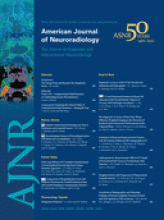We read the article of Kim et al entitled “Stenting from the Vertebral Artery to the Posterior Inferior Cerebellar Artery” with special interest.1 In their series, 2 patients had vertebral artery (VA) dissecting aneurysms involving the posterior inferior cerebellar artery (PICA) origin. The authors used VA-to-PICA stent placement with occlusion of the VA by coil embolization. They provided a new treatment option for VA dissecting aneurysms involving the origin of PICA. In this letter, we will discuss alternative treatment options for these complex aneurysms.
In recent years, various endovascular strategies have been used to treat VA dissecting aneurysms, including internal coil trapping, proximal parent vessel occlusion, stent-assisted coiling, or stent-only therapy.2 Internal coil trapping of the dissected segment has been considered one of the most reliable treatments, especially for ruptured VA dissecting aneurysms. However, this procedure is not suitable for patients with the dissecting segment involving the PICA. Although internal coil trapping including the PICA origin may also be considered, previous studies have demonstrated lateral medullary and cerebellar infarction due to PICA occlusion.3 Therefore, it is difficult to predict the consequences of a PICA occlusion. Proximal occlusion of the parent artery is an alternate strategy but does not protect from rebleeding because of retrograde flow to the dissected segment.
Recently, reconstructive endovascular treatment, including stent or stent with coil, has been applied to VA dissecting aneurysms involving the PICA. In theory, a stent might effectively tack down the torn vessel, resulting in aneurysm occlusion and preservation of the parent artery. However, there are still some limitations in treatment for ruptured VA dissecting aneurysms involving the PICA. First, although double stents or multiple overlapping stents may be more effective for obliteration of a dissecting aneurysm sac than a single stent, a relatively high rate of complete obliteration has not been achieved in the literature. Because it takes a long time for the aneurysm to be completely obliterated, stent-only therapy may not completely prevent the ruptured dissecting aneurysm from rebleeding. Second, conventional stent-assisted coil embolization is usually limited in the treatment of these aneurysms. The coil loop may protrude into the parent artery lumen or occlude the PICA, resulting in ischemic complications.
Therefore, if the contralateral VA is equal or greater than ipsilateral, we might prefer trapping with revascularization of the PICA by endovascular procedures as far as possible. VA-to-PICA stent placement is a valuable treatment option to preserve the patency of the PICA.1,4 In our experiences with 3 patients, we placed an Enterprise self-expanding stent (Cordis, Miami Lakes, Florida) from the distal or proximal VA to the PICA to save the patency of the PICA and occluded the aneurysm by coiling. However, a stent sometimes cannot be inserted into the PICA because of the small size of the PICA and/or acute angulation to the VA. Therefore, we use intra-/extra-aneurysmal Neuroform stent (Boston Scientific, Natick, Massachusetts) placement to protect the PICA for selected cases.5 Because of its open-cell design, the distal aspect of the stent within the aneurysm fundus acts to capture and restrain the initial coils, holding them within the aneurysm and allowing neck reconstruction.
References
- © 2012 by American Journal of Neuroradiology







